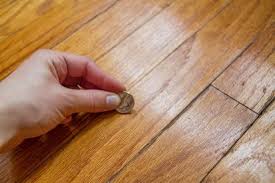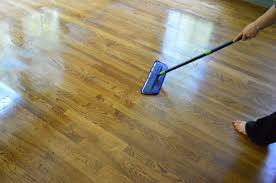How do I know if my hardwood floors are sealed?
If your home or apartment sports a hardwood floor, it is important for you to know if the floor has been treated or finished so that you can clean and care for it in the right manner. It is quite common to find unfinished wooden floors in older homes and apartments, while finished or sealed floors are characteristic of contemporary homes, with different sealing or treatment choices available in the market today.
Real wood floors today are basically treated with surface-sealants (synthetic resins such urethanes or polyurethanes) or penetrating sealants. Sealants can be water, oil or solvent based formulations. As the name suggests, sealants either cover the surface or penetrate into the wood. Apart from these finishes, hardwood floors may either be simply coated with wax or varnish. Shellac and lacquer finishes are sparingly used.
You can carry out a few simple tests in an inconspicuous area of the floor to determine if the floor is sealed.
- Water Drop Test
Place a drop of water on the floor. If it simply sits there and stares you in the face, congrats, your floor is a finished one. If it is absorbed, the floor is probably not finished or the sealant has worn out.
- Surface Test With Steel Wool
Rub some steel wool on the floor and check for residue. Wax is bound to surface as a grey film on the wool if the floor has been wax-finished.
- Acetone Swab Check
Wipe the floor with a nail polish remover (acetone based). Varnish, shellac and wax finishes will give way while polyurethane finishes will stay intact.
If you’re absolutely clueless about the finish of your hardwood floors, check out your local retail flooring store for a generic wood-friendly cleaning product to play it safe. If you are trying out a new cleaning product, equipment or technique, a small scale trial is definitely the way to go. Always make sure to choose a small area of the floor that is likely to stay hidden from direct view, a carpeted area or an area in a remote part of your home is a preferable choice for a trial.

How do I know if my Hardwood Floors Are Sealed? Easy tests revealed
I was trying to figure out how I would know if my hardwood floors are sealed. I had just finished completing my refinishing project for my floors and wanted to test them. Mostly, I wanted to make sure that the hard work had paid off.
So how do I know if my hardwood floors are sealed? Get a small glass of water. Locate an out of the way area that is not on a seam for the hardwood boards. Pour a small amount on the wood. If it stands for 5 minutes without soaking in, your hardwood floors are sealed. If it touches a seam, try again with a smaller amount in another area.
In this discussion, we will talk about a couple of tests you can do to see if your hardwood floors are sealed. We will also go over the next steps if you should find that the hardwood floors are not sealed.

What kind of finish is my hardwood floors?
To tell the difference in a pinch, just rub your finger across the floor. Be sure to do this on a clean floor. If no smudge appears, the floor is surface sealed. If you do create a smudge, the floor has been treated with a penetrating seal, oil finish, shellac, varnish or lacquer, and then waxed. Consider when your floors were installed as well. If you have a newer wood floor, it is likely surface sealed.
- Protect hardwood floors from dirt and grime
Use floor mats near your entry doors. You can reduce hardwood floor cleaning time and wear by adding mats at your entrances. Position mats both outside and inside exterior doors to lessen tracked-in dirt. Tiny particles, like dirt, can act like sandpaper and scratch your wood. By placing a floor mat at each entryway and encouraging family members and guests to wipe their feet, the majority of dirt and grime will remain on the mat.
In snowy or rainy weather, include a boot or shoe removal area to avoid damage from water and de-icers. Prevent marks by using floor protectors under furniture and by using rugs in play areas to ensure children’s toys don’t scratch the floor.
- SWEEP FOR DAY TO DAY HARDWOOD FLOOR
It might seem a little old-fashioned but the best way to clean your hardwood floor from day-to-day wear is sweeping with a high quality broom or using a microfiber cloth. If sweeping isn’t enough or those edges and corners need some attention, pull out the vacuum. Be sure to vacuum without the beater bar rotating which can scratch your hardwood floor finish.
- Use appropriate cleaning products
When possible, use cleaning products recommended by the flooring manufacturer. In some cases failure to follow the recommendations can result in voiding your warranties. If the floors were finished on-site, talk with the installer for product recommendations. If neither is known, use a generic hardwood floor cleaner which can be purchased at a retail flooring store. Always test the cleaner first in some obscure corner, such as closet or pantry to make sure you are using the right product.
- Never use anything with wax or petroleum-based products in it, unless you know for sure that your floor is a wax finish (this is no longer very common). Wax and oil will actually hold onto the dirt, and then when you step on it, it will scratch the surface. Also, if you use a wax or oil, it can eliminate the ability to buff and coat your floor–a full refinish could be required, because the finish won’t adhere and will peel off.Cleaning hardwood floor properly
- Clean up spills and stains quickly
Wipe up any spills immediately, using a soft, dry or slightly damp cloth. Start at the edges of the spill and work toward the center. Allowing spills to remain on hardwood floors could damage the finish, as well as the wood. Be sure that the floor is dry after clean up.

How to Care for Your Hardwood Floor
There are some solvent based cleaners that are specifically for unsealed hardwood floors, but often you can buff the existing floor (and wax) to restore shine. Adding new waxing products to floors should be something that is done every six to 12 months, at most.
If you just need to clean your waxed floors from common foot traffic, here are some steps to get the job done:
- Cut a hole into a terry cloth hand towel or rag.
- Place towel over the head of the mop by sliding the pole through your rag’s hole.
- Spray the rag with an aerosol unfinished floor cleaner or a little bit of white vinegar.
- If you use any water during this process, be sure to wipe up any excessive amounts with a fresh towel. If minimal water was used, be sure that the floor fully air dries.
- Buff hardwood floors with a clean terry cloth towel on the mop head, or you can find specialty buffing rags in the automotive care section of general variety stores or auto supply stores. Use a circular motion and do not apply pressure to the mop.
How to tell if your floor is sealed
I want to help identify these types of floors and how to tell if they are sealed or not.
Wood
To tell if your wood floor is sealed, find an inconspicuous area, dab a drop of water on the surface, and see if it soaks in or beads on top. If the water drop beads on top of the wood, your floor is sealed. Surface-sealed floors are stain and water-damage resistant and easiest to clean. Unless the floor is worn, it should be ready for acrylic and wax applications.
Tile
If the tile has been sufficiently sealed, when you do the bead test, you should see that the water beads up on the surface and will also ‘roll’ across the tile as you blow on it. If not – then either it has not been sealed correctly, or it requires preparation and re-sealing. As with ceramic floors, the grout also needs to be sealed before using waxing or floor shine products.
Laminate
Most laminate flooring is sold already sealed, but it is obtainable in an unfinished state. To tell if your laminate floor is sealed or not, go to an inconspicuous area of the floor (the back of a closet perhaps) and start with the water bead test. If the water soaks in or the floor changes color, it is unsealed. Another way of testing for sealant is to gently scrape a small area with a blade edge or a coin. If you see a bit of clear material on the edge, it is most likely sealed.
If you do not want to do the bead or scrape test, look for signs like lifting edges at the seams, especially in water-prone areas, such as the bathroom and kitchen. The laminate or adhered wood skin can begin to peel off the manufactured base over time, especially if it was left unprotected and wet. Laminate
Most laminate flooring is sold already sealed, but it is obtainable in an unfinished state. To tell if your laminate floor is sealed or not, go to an inconspicuous area of the floor (the back of a closet perhaps) and start with the water bead test. If the water soaks in or the floor changes color, it is unsealed. Another way of testing for sealant is to gently scrape a small area with a blade edge or a coin. If you see a bit of clear material on the edge, it is most likely sealed.
If you do not want to do the bead or scrape test, look for signs like lifting edges at the seams, especially in water-prone areas, such as the bathroom and kitchen. The laminate or adhered wood skin can begin to peel off the manufactured base over time, especially if it was left unprotected and wet.